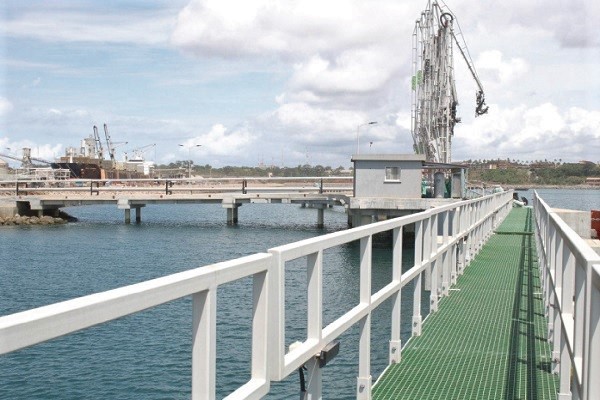
Takoradi Port oil jetty project nearing completion
Work is almost completed on an automated oil jetty at the Takoradi Port.
The $56 million project, which is a solid structure built out into the sea for loading and discharging of seagoing vessels, will have a capacity to discharge 80,000 tonnes of oil per stream day at the port.
Advertisement
Financed by Ibistek Ghana Limited through a special purpose company, Marshall Oil Services, under a concession agreement with the Ghana Ports and Harbours Authority (GPHA), the facility will replace the existing jetty which has a limited capacity of 20,000 tonnes per day.
The 303-metre long facility will be able to receive bigger oil carrier vessels, enabling berthing of oil carriers between 5,000 and 50,000 Deadweight (DWT) that carry between 27,000 and 50,000 litres of products.
Port expansion
The project forms part of the Takoradi Port expansion project being undertaken by Ibistek to expand the port’s capacity to create a cargo holding space of one million twenty-footer equivalent units (TEUs), an upscale from the average container traffic of about 55,000 TEUs a year.
The relocation of the jetty became necessary following the commencement of work on the multi-purpose container terminal and its associated facilities at that port.
More provisions
The Project Engineer at Amandi Holding, contractors for the project, Mr Gideon Anderson, told the Daily Graphic last Wednesday, that provisions had also been made for a 10-metre high fire monitor that will fight fire where necessary on both the loading arms and the discharging vessel.
He said following the completion of work on phase one, which involved the building and installation works of the vessel berthing platforms and the discharge equipment, phase two works which included the slop tanks, to serve as a collection point (drain) of oily mixtures that will be washed from the pipelines, were undergoing finishing touches.
Additionally, anti-corrosive paint was being applied to the pipelines to prevent them from rusting, ahead of the reception of the first vessel in June.
“The facility can take one vessel at a time but the turnaround time is much faster and will allow vessels to discharge three times faster than what used to be the case with the old jetty,” Mr Anderson explained.
Loading arms
The facility, he said, would have five separate loading arms installed to allow for the discharge of finished petroleum products such as diesel (gasoline), liquefied petroleum gas (LPG), heavy fuel oil (HFO) premium motor spirit (PMS) as well as bitumen from vessels.
When completed, he said, the products would be transported through the pipelines to a point that allowed the Bulk Distribution Companies (BDCs) to tie-in their pipes to offtake the products from the lines into storage.
The facility also comes with a control room to serve as a command centre that will manage the automatic product discharge operations on the jetty.
Onsite tanks
The Chairman of Ibistek, Mr Kwame Gyan, also told the Daily Graphic that the construction of the new jetty had seen space being created for an onsite development of petroleum storage facilities within the enclave.
Presently, most of such storage facilities, he said, were outside the port premises, necessitating the need for BDCs to have feeder pipelines to create a tie-in on the lines connecting to the jetty.
“For now, the facility is ready for inauguration and what is needed in the Takoradi catchment area is storage space, which is our next priority to enable the jetty to be fully optimised, and we encourage other private participants to take advantage of the opportunity to develop tank farms for the holding of the products on-site,” Mr Gyan said.



